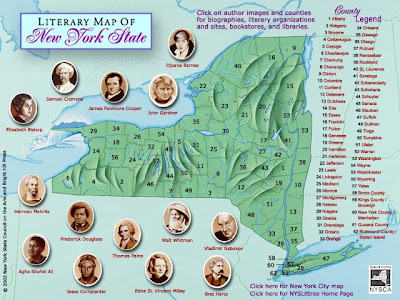Guidebooks & maps: literature programs at other state arts agencies
Uncategorized | December 12, 2007
 One of the great things about attending national conferences is hearing about what other state arts agencies are doing, especially in regards to individual artists. It may come as no surprise that state literature programs are publishing maps and guidebooks to highlight their writers, as well as how-to manuals to assist their careers. Wyomingarts readers may remember our 2003 anthology, “Deep West: A Literary Tour of Wyoming.” It was a project of the Wyo. Center for the Book, but I served as one of the co-editors. It featured excerpts and original essays from 19 of the state’s writers (14 were WAC fellowship winners) as well as a literary map.
One of the great things about attending national conferences is hearing about what other state arts agencies are doing, especially in regards to individual artists. It may come as no surprise that state literature programs are publishing maps and guidebooks to highlight their writers, as well as how-to manuals to assist their careers. Wyomingarts readers may remember our 2003 anthology, “Deep West: A Literary Tour of Wyoming.” It was a project of the Wyo. Center for the Book, but I served as one of the co-editors. It featured excerpts and original essays from 19 of the state’s writers (14 were WAC fellowship winners) as well as a literary map.
The North Carolina Arts Council has teamed up with the University of North Carolina Press on a three-volume series, “Literary Trails of North Carolina.” The first one covers the mountain region, and was edited by Georgann Eubanks, one of the founders of the North Carolina Writers’ Network. It features 18 one-day tours (maps included) of the western part of the state that places you “in the middle of the communities, historic sites, and hangouts of notable writers of fiction, poetry, creative nonfiction and plays.”
I went right to the index to look up Thomas Wolfe, one of my favorites. His fellow citizens in Asheville didn’t take kindly to his thinly-veiled portraits of them in “Look Homeward, Angel.” His mother’s rooming house, referred to as “Dixieland” in the novel, was falling apart until a local group renovated it and opened it as the Thomas Wolfe Memorial. Wolfe’s mother, Julia, once told F. Scott Fitzgerald that she didn’t rent her rooms to drunks referring, we can assume, to F. Scott himself.
Another Wolfe in the book is contemporary writer Tom Wolfe, best known for “The Right Stuff” and “The Electric Kool-Aid Acid Test.” This native of Virginia wrote about a character from Alleghany County in the remote western edge of N.C. in his latest novel, “I am Charlotte Simmons.”
Other writers in this volume: Anne Tyler, Romulus Linney, Sequoyah, Gail Godwin, Elizabeth Spencer, Nina Simone, and many others. For more info, go to http://www.uncpress.unc.edu. Or you can contact literature coordinator Debbie McGill at the N.C. Arts Council. We can look forward to the companion volumes, featuring the central part of the state and the coast.
The New York State Council on the Arts and Bright Hill Press teamed up for the state’s literary map. New York, of course, has a rich literary history. The color map includes Mark Twain, who lived for a time in his wife’s home town of Elmira; Willa Cather, who left Nebraska for Greenwich Village; James Baldwin of Harlem and Greenwich Village; Agha Shahid Ali, who taught in Binghampton, N.Y., and once was a judge for the WAC writing fellowships; and Herman Melville from, as they say here, upstate. On the flip side of the map is an index of the state’s “literary lives.” It includes county-by-county lists of writers, and a whole section of authors from New York City. There’s also a guide to literary sites. You can read more at the N.Y. State Literary Website at http://www.nyslittree.org.
The Illinois Arts Council, in cooperation with the Neighborhood Writing Alliance in Chicago, has compiled a booklet on “How to Get Published.” It’s a basic how-to guide for writers. Topics include “editing tips” (proofread!), “writing programs, conferences, workshops, and readings,” and “copyrights.” It’s very good for beginners but also has some reminders for established writers. Example: “Always investigate a contest’s reputation before sending money.”
The Illinois Arts Council may send you a copy if you ask nice. Contact the IAC at iac.info@illinois.gov.
- Select
- April 2024
- March 2024
- February 2024
- January 2024
- December 2023
- November 2023
- October 2023
- September 2023
- August 2023
- July 2023
- June 2023
- May 2023
- March 2023
- February 2023
- January 2023
- November 2022
- October 2022
- September 2022
- August 2022
- July 2022
- June 2022
- May 2022
- April 2022
- March 2022
- February 2022
- January 2022
- December 2021
- November 2021
- October 2021
- September 2021
- August 2021
- July 2021
- June 2021
- May 2021
- April 2021
- March 2021
- February 2021
- January 2021
- December 2020
- November 2020
- October 2020
- September 2020
- August 2020
- July 2020
- June 2020
- May 2020
- April 2020
- March 2020
- February 2020
- January 2020
- December 2019
- November 2019
- October 2019
- September 2019
- August 2019
- July 2019
- June 2019
- May 2019
- April 2019
- March 2019
- February 2019
- January 2019
- December 2018
- November 2018
- October 2018
- September 2018
- July 2018
- June 2018
- May 2018
- April 2018
- March 2018
- February 2018
- January 2018
- December 2017
- November 2017
- October 2017
- September 2017
- August 2017
- July 2017
- June 2017
- May 2017
- April 2017
- March 2017
- February 2017
- January 2017
- December 2016
- October 2016
- September 2016
- August 2016
- July 2016
- June 2016
- May 2016
- January 2016
- December 2015
- November 2015
- October 2015
- September 2015
- August 2015
- July 2015
- June 2015
- May 2015
- April 2015
- March 2015
- February 2015
- January 2015
- December 2014
- November 2014
- October 2014
- September 2014
- August 2014
- July 2014
- June 2014
- May 2014
- April 2014
- March 2014
- February 2014
- January 2014
- December 2013
- November 2013
- October 2013
- September 2013
- August 2013
- July 2013
- June 2013
- May 2013
- April 2013
- March 2013
- February 2013
- January 2013
- September 2012
- August 2012
- July 2012
- June 2012
- May 2012
- April 2012
- March 2012
- February 2012
- January 2012
- December 2011
- November 2011
- October 2011
- September 2011
- August 2011
- July 2011
- June 2011
- May 2011
- April 2011
- March 2011
- February 2011
- January 2011
- December 2010
- November 2010
- October 2010
- September 2010
- August 2010
- July 2010
- June 2010
- May 2010
- April 2010
- March 2010
- February 2010
- January 2010
- December 2009
- November 2009
- October 2009
- September 2009
- August 2009
- July 2009
- June 2009
- May 2009
- April 2009
- March 2009
- February 2009
- January 2009
- December 2008
- November 2008
- October 2008
- September 2008
- August 2008
- July 2008
- June 2008
- May 2008
- April 2008
- March 2008
- February 2008
- January 2008
- December 2007
- November 2007
- October 2007
- September 2007
- August 2007
- July 2007
- June 2007
- May 2007
- April 2007
- March 2007
